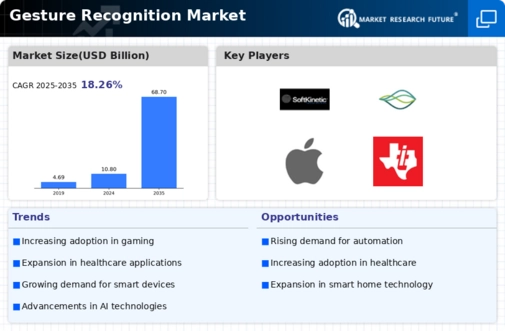Market Trends
Key Emerging Trends in the Gesture Recognition Market
The demand for 3D imaging is on the rise across various sectors, showcasing its increasing significance and adoption. Having been in existence for several decades, 3D technology has gained widespread popularity across diverse industry verticals. In the medical field, 3D imaging is playing a pivotal role in various segments such as radiography, magnetic resonance imaging, nuclear medicine, ultrasound, elastography, photoacoustic imaging, tomography, echocardiography, functional near-infrared spectroscopy, and magnetic particle imaging.
The advancements in technology, exemplified by multi-detector CT scanners, are fostering the integration of 3D imaging technologies among physicians and radiologists. These professionals are leveraging 3D imaging for accurate diagnoses and timely treatments, thereby enhancing patient care. In ophthalmology, the adoption of 3D imaging with display systems is steadily increasing, especially in microsurgeries, where precise visualization is critical.
The realm of robotics is experiencing a notable surge in the application of 3D imaging. It proves instrumental in detecting the position of objects in a three-dimensional space, contributing to improved spatial awareness and navigation for robotic systems. Beyond robotics, 3D imaging systems are being deployed in a multitude of applications. These include object tracking, product profiling, sheet of light applications, time-of-flight applications, and 3D X-ray imaging.
The sheet of light technology is particularly prevalent in electronics manufacturing as a widely used 3D imaging technique. This method involves projecting a laser beam from a camera to produce the profile of a moving object. As the object continues its motion, the camera captures multiple profiles, allowing for the reconstruction of the object with a unique profile. This approach is valuable for precision and detailed analysis in the manufacturing process.
Furthermore, the security and defense sector is experiencing substantial benefits from 3D imaging, particularly in facial identification, simulation, and target detection. The ability of 3D imaging to provide a three-dimensional representation enhances accuracy and efficiency in these critical areas. The technology is finding application in various domains, opening up new possibilities for inspection purposes and diverse applications.
In conclusion, the increasing demand for 3D imaging is reshaping industries and applications. From healthcare to manufacturing, robotics, and defense, the versatility of 3D imaging technologies is driving advancements and innovation across sectors. As technology continues to evolve, the integration of 3D imaging is expected to expand further, contributing to enhanced capabilities and improved outcomes in various fields.

















Leave a Comment